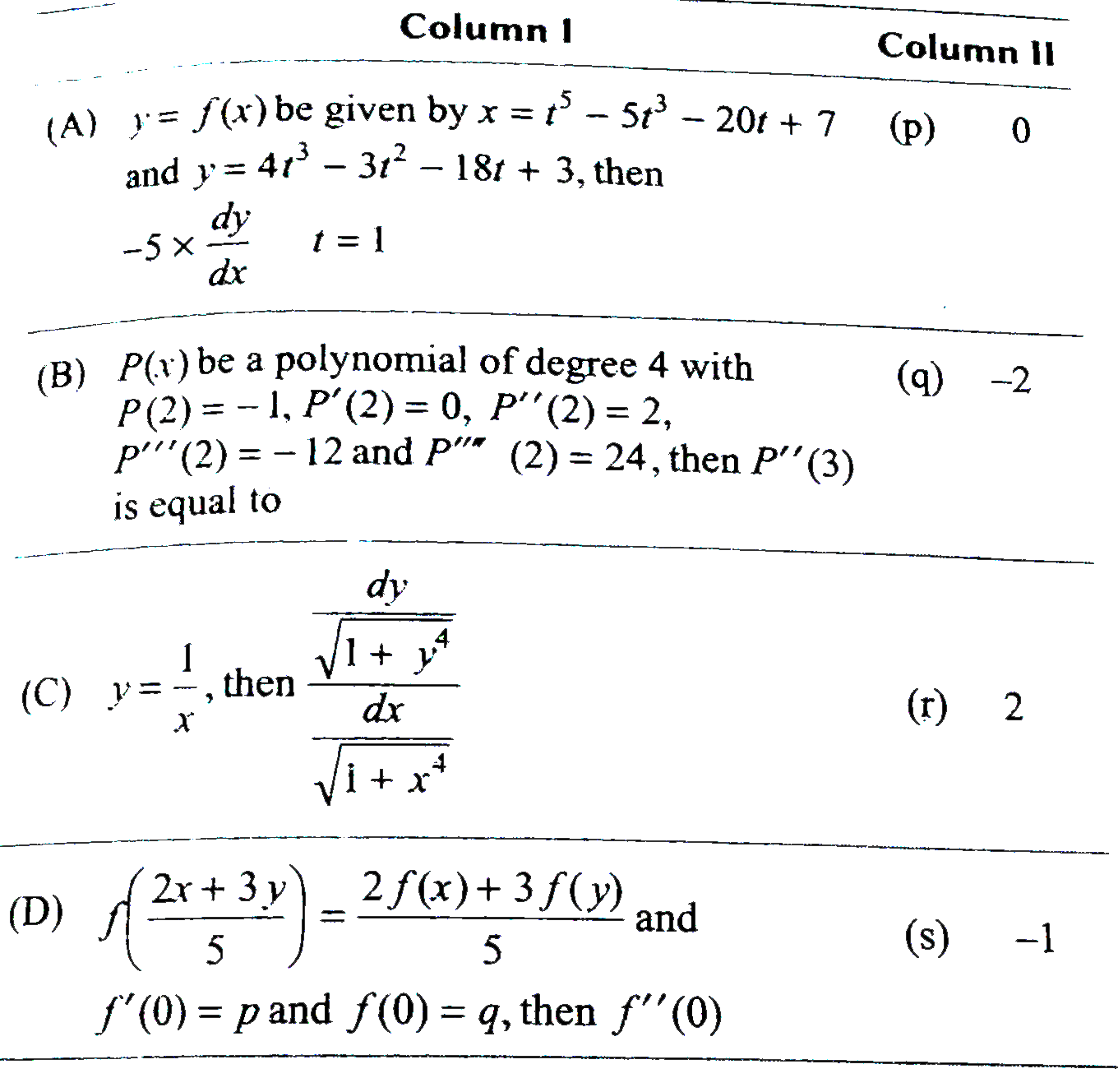Left hand derivative and right hand derivative of a function f(x) at a point x=a are defined as
f'(a−)=limh→0+f(a)−f(a−h)h
=limh→0+f(a+h)−f(a)h
andf'(a+)=limh→0+f(a+h)−f(a)h
=limh→0+f(a)−f(a+h)h
=limh→0+f(a)−f(x)a−x respectively.
Let f be a twice differentiable function. We also know that derivative of a even function is odd function and derivative of an odd function is even function.
If f is even function, which of the following is right hand derivative of f' at x=a?Solution in Punjabi
(a) limh→0−f'(a)+f'(−a+h)−h
(b) limh→0−f'(a)+f'(−a−h)h
(c) limh→0−−f'(−a)+f'(−a−h)−h
(d) limh→0+f'(a)+f'(−a+h)−h
The correct Answer is:A
Step by step video & image solution for Left hand derivative and right hand derivative of a function f(x) at a point x=a are defined as f'(a^-)=lim_(hrarr0^(+))(f(a)-f(a-h))/(h) =lim_(hrarr0^(+))(f(a+h)-f(a))/(h) andf'(a^(+))=lim_(hrarr0^(+))(f(a+h)-f(a))/(h) =lim_(hrarr0^(+))(f(a)-f(a+h))/(h) =lim_(hrarr0^(+)) (f(a)-f(x))/(a-x) respectively. Let f be a twice differentiable function. We also know that derivative of a even function is odd function and derivative of an odd function is even function. If f is even function, which of the following is right hand derivative of f' at x=a? by Maths experts to help you in doubts & scoring excellent marks in Class 12 exams.
Topper's Solved these Questions
- BOOK - ARIHANT MATHSCHAPTER - DIFFERENTIATION EXERCISE - Differentiation Exercise 5:2videos
DIFFERENTIATION
- BOOK - ARIHANT MATHSCHAPTER - DIFFERENTIATION EXERCISE - Exercise (Subjective Type Questions)14videos
DIFFERENTIATION
- BOOK - ARIHANT MATHSCHAPTER - DIFFERENTIATION EXERCISE - Exercise (Statement I And Ii Type Questions)8videos
DIFFERENTIATION
- BOOK - ARIHANT MATHSCHAPTER - DIFFERENTIAL EQUATION EXERCISE - Exercise (Questions Asked In Previous 13 Years Exam)26videos
DIFFERENTIAL EQUATION
- BOOK - ARIHANT MATHSCHAPTER - DY / DX AS A RATE MEASURER AND TANGENTS, NORMALS EXERCISE - Exercise (Questions Asked In Previous 13 Years Exam)7videos
DY / DX AS A RATE MEASURER AND TANGENTS, NORMALS
Similar Questions
Match the entries between the following two columns.
 02:48View Solution
02:48View SolutionIf f(x)=x3+x2f'(1)+xf''(2)+xf''(2)+f'''(3) for all x∈R. then find f(x) independent of f'(1),f''(2)andf'''(3).
01:13View SolutionConsider f(x)=xx2−1
Statement I Graph of f(x) is concave up for x>1.
Statement II If f(x) is concave up then f''(x)>0View SolutionIf f:R−{−1}→Randf is differentiable function satisfies:
f((x)+f(y)+xf(y))=y+f(x)+yf(x)∀x,
y∈R−{_1} Find f(x).03:21View SolutionThe slope of the tangent to the curve (y−x5)2=x(1+x2)2 at the point (1,3) is.
02:54View SolutionIf f(x) is a differentiable function of x then limh→0f(x+3h)−f(x−2h)h=
01:57View Solutionअवकलनीय फलन f, के लिए limh→0[f(x+h)]2−[f(x)]22h का मान-
03:22View SolutionLeft hand derivative and right hand derivative of a function f(x) at a point x=a are defined as
f'(a−)=–––lim(h→0+)f(a)−f(a−h)h
=limh→0+f(a+h)−f(a)h
andf'(a+)=limh→0+f(a+h)−f(a)h
=limh→0+f(a)−f(a+h)h
=limh→0+f(a)−f(x)a−x respectively.
Let f be a twice differentiable function. We also know that derivative of a even function is odd function and derivative of an odd function is even function.
If f is even function, which of the following is right hand derivative of f' at x=a?01:26View SolutionLeft hand derivative and right hand derivative of a function f(x) at a point x=a are defined as
f'(a−)=limh→0+f(a)−f(a−h)h
=limh→0+f(a+h)−f(a)h
andf'(a+)=limh→0+f(a+h)−f(a)h
=limh→0+f(a)−f(a+h)h
=limh→0+f(a)−f(x)a−x respectively.
Let f be a twice differentiable function. We also know that derivative of a even function is odd function and derivative of an odd function is even function.
The statement limh→0f(−x)−f(−x−h)h=limh→0f(x)−f(x−h)−h implies that for all x∈R,03:29View Solutionমনে করো f(x) অপেক্ষক x=1 –এ অন্তরকলন যোগ্য এবং limh→0(f(1+h)h)=5 , তাহলে f’(1) –এর মান হবে-
04:09View Solutionf(x)=1xহলে,limh→0f(1+h)−f(1)h-এর মান নির্ণয় করো|
04:29View Solutionf(x)=ax2+bx+c হলে দেখাও যে , limh→0f(x+h)−f(x)h=2ax+b
02:42View Solutionf(x)=1x হলে, প্রমাণ করো যে, limh→0f(2+h)−f(2)h=−14
02:56View SolutionProve that limh→0f(x+h)+f(x−h)−2f(x)h2=f''(x) (without using L' Hospital's rule).
04:05View Solutionकिसी बिंदु. x = a पर एक फलन f(x) का बायाँ और दायां अवकलज क्रमशः f(a−)=limh→0+(f(a)−h)h=limh→0+f(a+h)−f(a)h और f(a+)=limh→0+f(a+h)−f(a)h=limh→0−f(a)−f(a−h)h=limx→a+f(a)−f(x)a−x द्वारा परिभषित किया जाता है।
माना की f दो बार अवकलनीय फलन है। हम जानते है की सैम फलन का अवकलज विषम फलन तथा विषम फलन का सैम फलन होता है।
उपरोक्त जानकारी के आधार पर , निम्न प्रश्नों के उत्तर दीजिए :
यदि f विषम है तो निम्न में से कौन - सा पर x = -a का बायाँ अवकलज है -04:01View Solutionकिसी बिंदु. x = a पर एक फलन f(x) का बायाँ और दायां अवकलज क्रमशः f(a−)=limh→0+(f(a)−h)h=limh→0+f(a+h)−f(a)h और f(a+)=limh→0+f(a+h)−f(a)h=limh→0−f(a)−f(a−h)h=limx→a+f(a)−f(x)a−x द्वारा परिभषित किया जाता है।
माना की f दो बार अवकलनीय फलन है। हम जानते है की सैम फलन का अवकलज विषम फलन तथा विषम फलन का सैम फलन होता है।
उपरोक्त जानकारी के आधार पर , निम्न प्रश्नों के उत्तर दीजिए :
यदि f सम है , तो निम्न में से कौन-सा x = a पर f' का दायां अवकलज है -01:43View Solution

